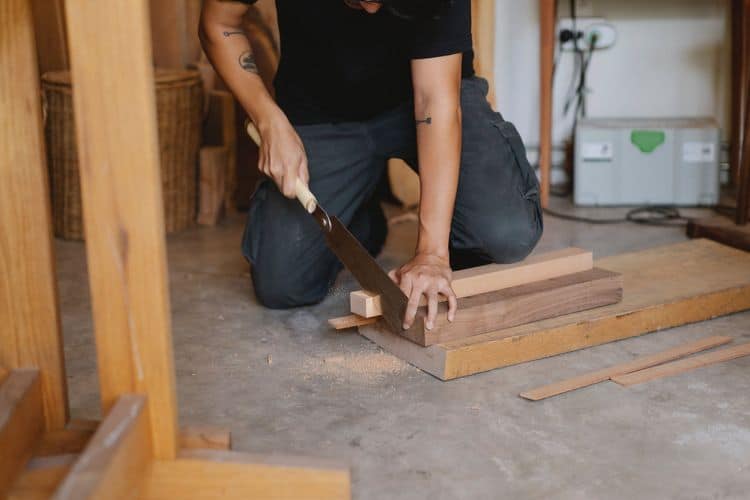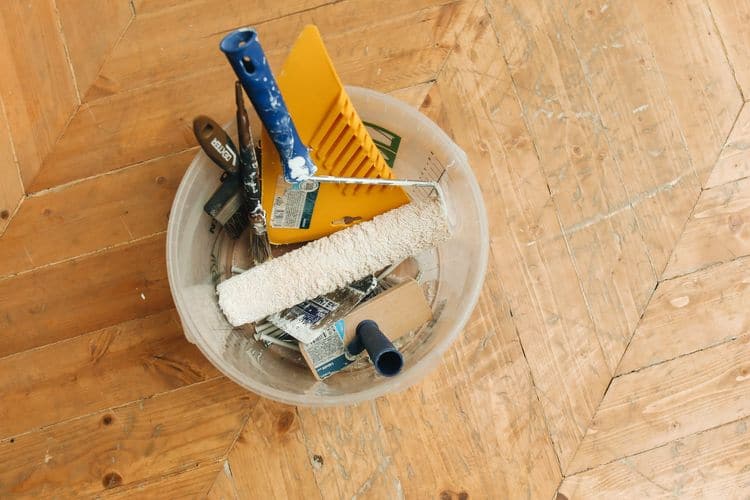
Are you looking for ways to repair wooden floors? In an old property, wooden floorboards add character and an air of uniqueness. However, maintenance, care & wood floor repair are essential to keep in mind as wood floors degrade.
With our helpful guide, you’ll learn to identify the damage and then get tips on fixing hardwood, laminate & squeaky floorboards. A skilled DIYer can handle most of these issues, but consult a professional if you require guidance or advice.
Hardwood & Laminate Wood Floor Repair
Hardwood flooring is more durable and long-lasting than softwood flooring & laminate flooring. In contrast, if you drop a heavy object or move the furniture recklessly, your hardwood floor will get dents.
Hardwood floors can get dents, no matter how strong they are. When walking around your home with children or pets, moving heavy furniture or while you’re wearing high heels, accidents can and will occur.
To replace hardwood tongue-and-groove floorboards that are damaged or have holes, you will need some sharp tools and a bit of knowledge about how to break the board edges that interlock. If you’re removing old flooring, create a new butt joint on the side nearest the hole or where the damage ends.
In addition, old flooring is challenging to match in color. Therefore, the best time for wood floor repair is when you are about to sand and refinish the entire floor. Otherwise, it’s an uphill task to level and finish the new plank with a belt & orbital sanders.
How to Remove Dents from Hardwood Floors
It is possible to rub a hardwood floor dent that has not penetrated all the way through and then refinish to remove damage. You can remove scratches from hardwood floors with a fine steel wool pad that will not damage the floor.
Here are some things to consider when removing dents from your hardwood floor:
- Using a different type of pad if you’re going to add a water-based finish afterward since water-based finishes do not interact well with steel wool powder.
- A touch-up stick with the right color might suffice if we’re talking scratches and not severe dents on a hardwood floor.
- A gouge is more severe than a dent because it involves breaking or fraying wood fibers. Besides, gouges make even the best hardwood floors look old and neglected. To repair gouges in hardwood floors, you may use wood fillers and putty.
- It would help if you filled in the wound to fix a gouge. Pick up wood filler at your local DIY store. The key here is to find a product that matches your floor’s color.
- Fill the gouge with the filler slowly and allow it to dry. Then sand the patch. You may even want to try filling in dents on a hardwood floor with a brown crayon and wiping away the excess wax.

How to Repair Laminate Floor
A laminate floor mimics the look of a wood floor, even though it contains multiple layers of natural and synthetic materials. Laminates are popular because of their affordable prices and are also easier to repair than hardwoods. A laminate floor comprises a plywood or particleboard base covered by a thin image layer. It provides long-lasting protection from damage, including UV rays.
Laminate floors can develop gaps because of uneven subfloors, improper installation of flooring underlayment, or temperature changes. You can effectively fill a small gap less than 1/8th inch at the end of a plank or along its edge with vinyl putty.
Match the shade of putty you choose as closely as possible to the floor. If you want to get a specific color, you can mix two or even three colors. Mix vinyl putty darker than the floor with lighter putty until you achieve the desired hue. Wear gloves and squeeze out a small amount of the darker putty onto a paper plate.
For mixing, use a small putty knife. Adding lighter putty in small increments will help you achieve your desired shade. Try mixing a third color if two don’t produce the right shade. Talk to a knowledgeable associate at your local flooring store if you need help choosing colors.
1. Dual Suction Cups Glass Lift
Tap the handle with a rubber hammer after gripping the plank with dual vacuum power. Keep tapping until the gap is closed. Work from one side of the floor towards the other, repeating this process with all gaps in the floor.
2. Hide Scratches With Markers & Crayons
For best results with this method, closely match the floor color. You can render small scratches almost invisible with the shade of markers, wax pencils or even crayons. They include specialty markers in laminate floor repair kits.
Buy a laminate repair compound kit if the scratches or dents are deeper. You mix and spread the pre-colored mixture over the scratch.
3. Soap Away Spongy Spot
Hard spots can develop because of an uneven subfloor or improperly installed flooring underlayment. Use an air inflation needle (used for blowing up sports balls) or a syringe to repair soft spots on your laminate floor quickly.
1. As an extension to a spray, foam can attach an air inflation needle. Apply crack-filling foam. Practice this before attempting the final installation.
2. Tape a layer of masking tape on top of the laminate to protect it.
3. Inject the foam under the planks by drilling a tiny hole in the middle of the soft spot.
4. Depending on the area’s size, you may need to make over one injection site.
5. Once the foam underneath the boards has been set up & becomes firm, remove any excess foam & cover the hole with duct tape. This is the most effective way to fix an uneven subfloor.
6. Use matching wood putty to fill in the injection sites.
Squeaky Wood Floor Repair
There are various reasons floorboards can become loose, but often it is simply that the fixing is no longer gripping the board in place. However, scrutinize breaking or fraying wood fibers carefully when lifting floorboards.
If your floorboards are loose or squeaking, here are some tips:
1. To minimize any squeaks, nail the board back into place with unique ‘cut’ floorboard nails. First, ensure no cables or pipes are directly underneath the board where the nails will go.
2. Screw battens back onto joists from below to reinforce.
3. Fixing boards with brass screws is better than using nails in places where they may need to be removed later or there are fragile ceilings below that hammering might damage.
4. Graphite or talc can sometimes silence squeaks between boards that rub against each other.
Unless the damage is extensive or you want to install high-quality floorboards or underlayment, removing the flooring is unnecessary. Businesses & homeowners can hire a property maintenance professional for severe damage and damage to the floorboards in the middle of a big room.

